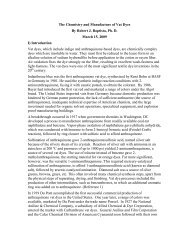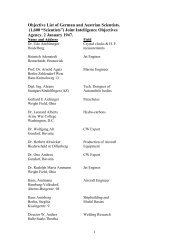International Dyestuff Industry - ColorantsHistory.Org
International Dyestuff Industry - ColorantsHistory.Org
International Dyestuff Industry - ColorantsHistory.Org
You also want an ePaper? Increase the reach of your titles
YUMPU automatically turns print PDFs into web optimized ePapers that Google loves.
Figure 4. Chlorine Ovens. Edelstein Collection, Hebrew University.<br />
The end manholes were slabs of wood covered with lead. The ovens were charged through<br />
openings at dd (b in the cross section), and the lids to these were made airtight with a<br />
liquid seal of "chlorine oils," the residual oil from the reaction, which was placed in the door<br />
channels. Lead piping was used to deliver the chlorine and carry away hydrochloric acid and<br />
unreacted chlorine from the last stages of the chlorination. Since this caused loss of the<br />
valuable reagent, the ovens were then operated in pairs so that outgoing gas from the first<br />
oven was then passed into the second.<br />
The next day a new charge of anthracene was placed in the first oven, the incoming gas<br />
was then directed into the second oven, to complete chlorination, and then passed through<br />
the fresh charge. By this continuous alternation in the supply of chlorine, losses were<br />
minimized.<br />
A steam chamber was built into the surrounding brickwork to maintain the desired<br />
temperature. Hydrogen chloride gas was recovered for re-use by condensation in coke<br />
towers. Wooden tools were used to loosen the crystalline dichloroanthracene remaining in<br />
the oven, which was then transferred to tubs and broken up in the presence of caustic soda<br />
which neutralized the hydrochloric acid. The product was afterwards separated from the<br />
solution and hydraulically pressed between linen cloths to remove unwanted materials as<br />
the “chlorine oils.”<br />
The resulting crystalline cake then underwent further purification by repeated breaking up,<br />
soaking in coal tar naphtha, and pressing. Any residual naphtha was recovered by steam<br />
treatment. Finally, the product dichloroanthracene was dried on trays in a drying room and<br />
was found to be about 84 per cent pure.<br />
In the important sulfonation step, the dichloroanthracene was treated with sulfuric acid in<br />
iron pots, each capable of holding about 30 gallons of liquid, and fixed in place in rows<br />
above ovens. The whole arrangement was surrounded by brickwork to retain heat (Perkin’s<br />
Figure 5).





